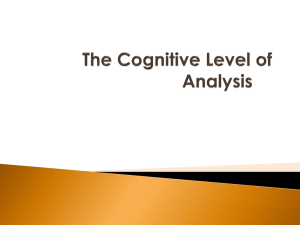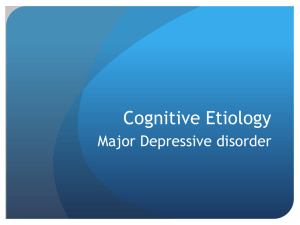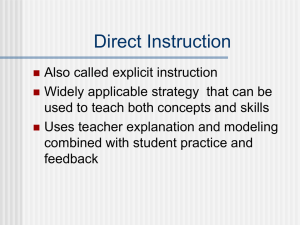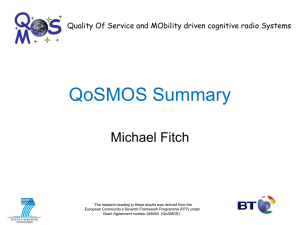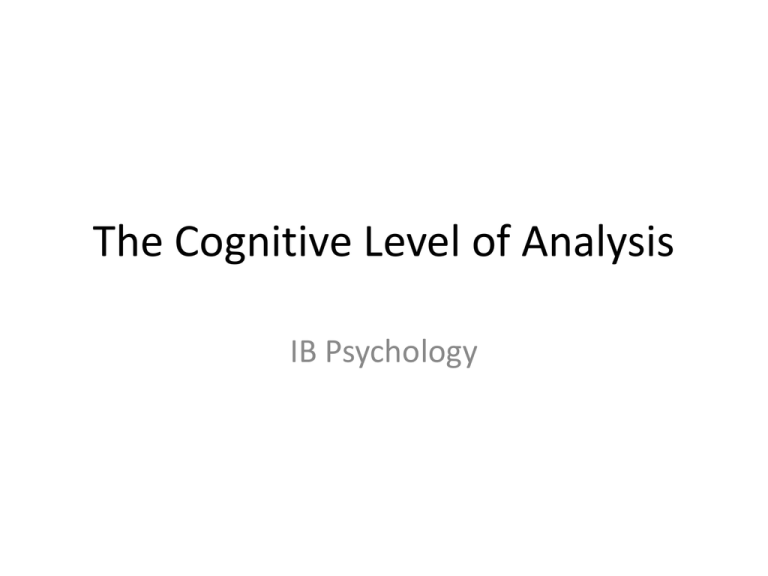
The Cognitive Level of Analysis
IB Psychology
Introduction
• Current view of the cognitive level
– Psychologists recognize that the mind has a
biological basis and develops within a cultural
context
• Has it always been this way?
A long, long time ago…
(19th centuryish)
• Early psychologists were cognitive psychologists
– Wilhelm Wundt (1832-1920)
• Studied sensation, perception, and attention
– Hermann Ebbinghaus (1850-1909)
• Studied memory
– J. Ridley Stroop
• Published famous Stroop test in 1935
• BUT…Cognitive psychology was not promoted as
the primary way of thinking in the US by the
1930s
– More fascinated with John Watson
John Watson
and Behaviorism
• Proposed that introspection was not
appropriate for the scientific study of
behavior.
• Until the 1960s, behaviorism dominated
psychology
• Some still chose to study cognitive processing
– Lev Vygotsky
– Jean Piaget
– Frederick Bartlett
Changing the way we think about
behavior…
• 9-11-1956
– Noam Chomsky gave presentation at MIT about
nativist language theory (language is innate)
– Clear that there was support for change
• 1957
– B.F. Skinner wrote Verbal Behavior
• Language was really a behavior
• A chain of verbal behaviors reinforced through verbal
operants and maintained by the sociocultural environment
– Chomsky criticized the verbal behavior principles
» Creative use of language was unexplainable and untestable
through Skinnerian principles
Jerome Bruner (1990)
and the demise of the traditional
learning theories
• Cognitive Revolution
– “Absorbed the concept of learning into the broader
concept of the acquisition of knowledge”
• Transactionalism
– Still rearranging psychology
• “It was the view that human action could not be fully or
properly accounted for from the inside out—by reference
only to intrapsychic dispositions, traits, learning capacities,
motives, or whatever. Action required for its explication that
it be situated, that it be conceived of as continuous with a
cultural world.”
• Bruner’s theory spans all three levels of analysis
and is important to the future of psychology
2.1 Outline principles that define the
cognitive level of analysis
• Cognitive psychologists assume that there is an important
biological basis for human cognitive processing and its
resultant behavior but focus research on how the brain
translates into mind.
• Mental processing in the mind can be studied scientifically.
Theories of cognitive processing are studied through
various methods.
• Behavior change is explained as a result of cognitive
processing that goes on in the mind. The steps of cognitive
processing are:
•
•
•
•
A.
B.
C.
D.
Information is acquired from the world.
The information is stored.
Stored information is represented in the mind.
Internal representations direct behavior.
Studying LANGUAGE as a cognitive
process
• Language is the most fundamental of all the cognitive processes
and is responsible for the development and use of the other human
cognitive processes, such as memory and perception.
• Language is the vehicle of cultural transmission and social learning
• Language separates humans and animals. Animal models are not
very useful for studying sophisticated human cognitive processing.
Animal studies primarily show the limitations of animal “language”
and “thinking.” Animal “thinking” is limited to the world of objects;
language is required. All other cognitive processes are removed
from objects because of language.
• Language is probably the most important of the sophisticated
cognitive processes that humans evolved so that we could live
together in cultures. It is part of the evolution of social intelligence.
Section 3.5
Page 32-36
• Give each group a section to present to the
class.
Mental Processes Guide Behavior
• Mind is an information-processing machine
using hardware (the brain) and software
(mental images and representations).
– Information input into the mind comes via
bottom-up processing—from the sensory system.
This information is processed by the mind by topdown processing via pre-stored information in the
memory. Finally, there is output in the form of
behavior.
Mental Processes Guide Behavior
• There is a relationship between how people
think about themselves and how they behave
– Ex. – How people deal with challenges.
• A person’s mindset is important in predicting
behavior.
– People who have fixed ideas about other people
(stereotyping) may be more prone to discriminate.
Mental Processes Guide Behavior
• Reconstructive nature of memory
– People do not store exact copies of their experiences,
but an outline which is filled out with information
when it is recalled.
• False memories
– Individuals cannot distinguish between what they
have experienced and what they have heard after the
event.
• The brain creates illusions which are so realistic that we
believe they are true.
– Examples?
Mental Processes Guide Behavior
• This is related to PERCEPTION
– Cognitive process that interprets and organizes
information from the senses to produce some
meaningful experience of the world.
• Context, frequency, or recency influence the way
people interpret an ambiguous object or event.
– What people think is objectively experienced may instead be
the result of the brain’s interpretation of the object or event.
Mental Processes Guide Behavior
• Perception and Necker cube
• Is the dot on the near or far corner? What
happens if you stare at the dot for a long time?
– The image has two equally meaningful interpretations
and the brain simply switches back and forth between
them.
– The brain interprets the picture the way it wants to,
searching for some meaning because it does not have
enough information to know exactly which face of the
cube is in front.
– What we see is the “best guess” of our visual system,
and the brain decides which one is favored.
Think about this
• “Our experience of the world—how we see it,
remember it, and imagine it—is a mixture of
stark reality and comforting illusion.”
– Daniel Gilbert
Language is fundamental to human
culture.
•
•
•
•
“The Ragin’ Cajun”– The Mind Traveler
Films from the Humanities and Sciences
Monkey in the Mirror
www.pbs.org
Discuss how and why particular research methods are used at
the cognitive level of analysis, including ethical concerns.
•
•
•
•
•
•
•
•
Experiments
Correlation studies
Naturalistic observation
Interviews
Questionnaires
Case Studies
Psychobiological research
Computer Simulations
Experiments
• Mainly using humans
• Lab, qausi-, and field
• Show cause and effect
• Lab experiment
– Clarify theoretical rather than real-life applications
– Supposed to be artificial
• Ex.: Jerome Bruner and language “Evaluate two
methods or theories of one cognitive process.”
Quasi-experiments
• Used when researchers cannot randomly
assign participants to conditions.
• Cross-cultural research and studies comparing
males and females use this design (placed in
groups according to culture or gender)
• Do not have same control as a lab exp.
Field Experiment
• Test experimental conditions in the natural
environment
• Do not have as much control as lab exp. but are more
ecologically valid
• Ex. Cross-cultural study on own-race bias (ORB) and
eyewitness testimony “To what extent is one cognitive
process reliable?”
Correlation Studies
• Shows relationship between two variables
• Used when it is unethical or difficult to create
conditions in a lab
– Ex.: Correlation data was used in addition to the
field experiment data in the ORB study on
eyewitness testimony.
Naturalistic Observation
• High ecological validity
• Lack of control
– Ex. Michael Cole’s study on the Kpelle in Africa
“Discuss how social or cultural factors affect one
cognitive process.”
Interviews
• Verbal protocols
• Self-reports
• Narrative interview
– Useful in cross-cultural studies
• Participants “tell their story”
– Useful for designing culturally valid experiments
• Weaknesses
– Time consuming
– Experimenter Bias
– The process of gathering data might interfere with
cognitive processing
Questionnaires
• Limitations
– Reliability of self-report
– Ex. Cross-cultural study on flashbulb memories
“Evaluate one theory of how emotion may affect
one cognitive process”
Case Studies
• Use information gathered from a wide range of
sources, such as interviews and observations
• Rely on psychobiological case studies to examine
brain deficits on cognitive processing
• Allow researchers to gather detailed data about
individuals that might not otherwise be available
• Limitation
– Cases are not representative of a larger group
• Ex. Emotions and the brain “To what extent do
cognitive and biological factors interact in
emotion?”
Psychobiological Research
• Cognitive processing and biological research studied
together
• Provides hard evidence of what happens in the brain during
cognitive processing
• Limitations
– This evidence cannot answer questions about brain functioning
– Information gathered from abnormal brains does not provide a
full explanation of cognitive processing
• Ex. fMRI study on the interaction of biology and cognition
in emotion “To what extent do cognitive and biological
factors interact in emotion?”
Computer Simulation
• They say nothing about how cognitions are
situated within a cultural context!!!
• Processes in computer simulations and in
studies using artificial intelligence are not
necessarily the same process as a human
brain uses.
Ethics of Cognitive Research
• Sometimes humans cannot be studied.
– Not usually the case, but sometimes animals are
used to examine how a specific brain deficit
relates to the ability to process information.
• Researchers, therefore, can create brain deficits.
• Deception is sometimes used in human
experiments. To use deception, the scientific
benefits of a study must be such that it
outweighs the rights of participants to be
informed.
Ethics of Cognitive Research
• Researchers should make every reasonable effort to protect
participants from harm. If someone is going to be exposed
to harm, the informed consent form should outline the
risks associated with the study in advance.
– Ex.: Studies documenting cognitive deficits caused by sleep
deprivation in labs
• Informed consent forms are critical components of
research at the cognitive level. All participants should be
debriefed about the exact nature of the study as soon as
possible after their participation.
• Observation studies DO NOT need the consent of
participants as long as the researcher does not alter the
natural environment in any way and the identity of
everyone observed remains anonymous.
Cognitive Processes are Influenced by
Social and Cultural Factors
• Frederick Bartlett
– Coined the term schema
• (a mental representation of knowledge)
• Bartlett was interested in how cultural schemas
influence remembering
– Found that people had problems remembering a story
from another culture, and that they reconstructed the
story to fit in with their own cultural schemas
• People remember in terms of meaning and what make sense
to them
– Therefore, memory is subject to distortions
» And this can be studied scientifically
Schemas
• Mental representations that can refer to
objects, ideas, and people in the real world
– We use them when we think, make plans,
imagine, or daydream
• Ex.: You have an idea of who you are and how you look
in your mind—a self-representation; You also have
ideas about how other people are
• Mental representations are organized in
categories, and the mind contains all sorts of
mental representations stored in memory
Schemas
• The ability to manipulate mental images enable us to
think about situations and imagine what might happen.
– Ex.: Reading a book
• We also have expectations…how people are going to
fare (good guys vs. bad guys) because of pre-stored
mental representations (cognitive schemas)
– “Mental representations” are how we store images and
ideas in memory
• Memory researchers believe that what we already know affects
the way we interpret events and store knowledge in our memory
Schema theory
• Schema theory suggests that what we already
know will influence the outcome of
information processing
– Based on the assumption that “humans are active
processors of information”
• Encoding (put into memory), storage
(maintain in memory), retrieval (recover from
memory)
Limitations of schema theory
• Not entirely clear how schemas are acquired
in the first place and how they actually
influence cognitive processes
• Cohen (1993) criticized theory saying that it is
too vague to be useful
• Daniel Gilbert “the brain is a wonderful
magician but a lousy scientist”
– The brain searches for meaningful patterns but
does not check whether they are correct.
Let’s Review Schemas
•
•
•
•
•
We have schemas for everything we do
It is a fundamental part of modern psychology
Span all levels of analysis
Biologically based
We categorize information and the categories
change as we age and interact
• Culture determines the content of schemas
• Schemas influence the mind
Evaluate Schema Theory with
Reference to Research Studies
• Humans are born with basic survival behaviors that
form the basis of schemas (ie. bonding) but MOST
schemas develop within one’s cultural context
• Cultural schemas are part of CAD (cultural acquisition
device)…they are built in
• Cultures do not just filter perceptions but actively build
schemas about expected behavior
– Ex.: Konner 2007, In New Guinea it is common practice to
give all goods and services to one respected man who is
trusted to distribute them fairly. Attitudes about handling
all goods and services reflect this practice.
Evaluate schema theory with reference
to research studies
• Schemas and mental illness
– Genetic determinism is no longer acceptable in
explaining mental illness
• Cultural schemas offer a better framework
– All cultures have schemas about abnormal
behavior…but the details vary
Evaluate schema theory
Schemas and Mental illness
• Richard Castillo (1997)
– Cognitive schemas are created in cultural groups based on
how the group thinks about and experiences behaviors
• These cog. schemas reify a belief into something real for the group
– Reifying “occurs when people are collectively projecting onto an object a
level of reality the object does not actually possess.”
– The way a behavior is thought of in a cultural group is real to them, even
if it does not exist in reality.
– The brain adapts to these cultural schemas and the group
treats a set of behaviors as real mental illnesses
• How does reification give us an international perspective on all
behaviors?
– It influences how societies come to label anything as important, sch as
intelligence or achievement testing…Do not assume that others outside
of your culture share your schemas!!!
Evaluate schemas theory
How do schemas form about mental
illness?
• Castillo
– A specific behavior is noticed by a cultural group and
is interpreted as a mental illness within a cultural
definition
• Neuroplasticity—how schemas grow and change
– Schemas serve three purposes
• Representational
– Serving important symbolic functions for a group
• Constructive
– Consisting of a social agreement about what is important to a
society that is communicated through stories
• Directive
– Telling people what is important to do.
Evaluate schemas theory
Schemas and mental illness
• Depression
– It is difficult to diagnose depression outside of
Western cultures
• “Major depression” – in US, there is a specific set of
behaviors
– Based on how stress is generally expressed in US
– It is ethnocentric to believe this is how someone
experiences depression in other cultures
• Etics and emics help explain why…
Schemas and Mental Illness
• Stress is an etic
– Something common to all cultures
• Different experiences in expressing stress
– These are emics
• Example: The word depression means something
different in Pakistan
– An interview study about the emics of depression in Pakistani
ethnic groups living in the United Kingdom
Schemas and Mental Illness
• China
– Stress is more often experienced in bodily symptoms
• CCMD (Chinese Classification of Mental Disorders)
– Has category “depressive episode”, however not used as
frequently as in West
• Often rely on TCM for explanations and treatment or
combine psychiatry and TCM
– TCM makes no distinction between physical and mental health
(Bodily symptoms have far greater meaning)
• Castillo emphasizes that the depressive
symptoms experienced in the West are not as
important to Chinese cultural schemas – and little
attention is paid to them
Gender schemas and depression
• Women are diagnosed far more often than men
• Depressive symptoms may be related to cultural
schemas about how females are expected to express
distress
• Sandra Bem (1998)
– Children need cognitive consistency
• Once a child constructs a gender schema, this representation
serves as a reference point for what is valued about being male or
female
– Does not believe that gender has to be a category; it is not naturally
more perceptible for children than other attributes
» Anything used as a category for schemas is only relevant if given
functional significance for the group
» Bem promotes raising children free of gender schemas
Gender schemas and depression
• Gender schema processing is studied experimentally
• Example
– 48 male and 48 female participants were designated as sex typed or
non-sex typed through the Bem Sex Role Inventory
• http://www.neiu.edu/~tschuepf/bsri.html
• http://faculty.sunydutchess.edu/andrews/bem_sex.htm
– Viewed 61 randomly ordered words at 3 second intervals (including
animal names, proper names, and clothing)
– Some words were feminine and some masculine
– As hypothesized both males and females recalled equal numbers of
words, but the order in which the words were recalled differed
between designation
• Ex.: Sex-typed participant that recalls a feminine word, went on to recall a
series of feminine words in clusters
– Sex-typed people are more likely to create categories based around
gender
How does this relate to depression?
• According to Bem
– “sex-typing results, in part, from the assimilation
of the self-concept itself to the gender schema.
As children learn the contents of their society’s
gender schema, they learn which attributes are to
be linked with their own sex, and hence, with
themselves.”
• Gender schemas may be related to how women
experience stress!
Evaluate two models or theories of
one cognitive process
• Vygotsky and Bruner on Language
– Language is primarily responsible for cognitive
development.
Vygotsky and Language
• Thought and Language (1934)
– Rejected the idea that animals had language
– Human thought is tied to language and animal
thought is not tied to their communications.
– Animal abilities are limited without the technical
aid of language.
Vygotsky and Language
• Built a framework for thinking about the importance of
language to a child’s development
– Examined the process by which elementary thought, which
is recall in children, becomes internalized abstract thought
– Cognitive processes such as memory, attention, problem
solving, and perception are dependent on language.
– Interactionist – a child develops with the help of parents,
teachers, and play
• Interactions with others take place within a cultural context
– Michael Cole (2003) defines Vygotsky’s context as “the social situation of
development is a relational construct in which characteristics of the child
combine with structure of social interactions to create the starting point
for a new cycle of developmental changes which will result in a new, and
higher, level of development.”
Vygotsky and Language
• Language and thought begin as separate
functions in early development
– During the 2nd year, language and thought follow
separate paths.
• There are prelinguistic and pre-thought behavior actions in
babies
– When thought and language meet as the child
develops, thought becomes verbal and speech
rational
– The child then moves rapidly into symbolic thought –
far beyond animal development
Vygotsky and Language
• Calls egocentric speech “externalized speech” and claims it is
socially motivated
– Represents a time in a child’s development when thought and speech
are still unifying
• Lang. dev. is responsible for a child’s general cognitive development
• A child’s ability to think abstractly and use all of the other cognitive processes
depends on language
• All development depends on the social environment and what
happens within the ZPD
– “the difference between the actual dev. level as determined by
independent problem solving and the level of potential development
as determined though problem solving under adult guidance or in
collaboration with more capable peers.”
– the difference between what a learner can do without help and what
he or she can do with help
Vygotsky and Language
• Development and Learning
– Learning refers to task acquisition
– Development deals with level of functioning that a child exhibits
– Learning awakens the developmental process
• The ZPD arises from the theory of development
– The ZPD creates the environment where external processing in
children becomes internalized symbolic thought.
• Play is an important ZPD! Why?
– Vygotsky’s “sisters”
» Asked real life sisters to “play” being sisters
» Real life, sister behavior goes unnoticed. In play, more concerned with
showing “sisterhood”
– Real play is socially and culturally motivated and contributes to
development
– Children use language in play to make sense of the world
Jerome Bruner
Language and cognitive development
• Noam Chomsky’s LAD is an incomplete model of how
children use language
– Downplayed the role of parenting and culture
• Bruner
– Language acquisition support system (LASS)
• Explains how children move from innate prelinguistic skills to
making meaning within the cultural context of a child’s life
• Parents are scaffolds (supporting frameworks) for development
– Theories have method, observer, time, and space (cross-cultural)
triangulation
– Experimental evidence…BUT advocates nonexperimental methods–
natural setting (real interactions between child and adult)
Jerome Bruner
Language and Cognitive development
• Human minds evolved in the context of a
symbolic culture shared by others
– Intersubjectivity
• Interplay between adults and children long before
children have actual language
– Reciprocal relationship where one has an intention to connect
to the other and decode what the other person intends to
convey (a TOM)
» Intentions are uniquely human and probably have bio
basis…babies come into the world with schemas to figure
out the intentions of others
Jerome Bruner
Language and cognitive development
• Ex.: A mother cat teaches her kittens how to
use a litter box, but teaching is innately wired
– It is not a cognitive intention coming from a
sophisticated brain that is considering all the
possibilities for a child
– Does not consider raising child to become
president.
• In contrast, human scaffolds spend their time
making the world manageable for children
Jerome Bruner
Cognitive and Language Development
• Cognitive development is largely dependent on language
– Three phases (enactive, ikonic 2-5, symbolic 6-7)
• Outcome of development depends on how children are
instructed
• Ex.: A mother and baby played peek-a-boo to demonstrate
the intersubjective experience between mother and child.
The mother initiates the game and the baby responds with
babbling and eye contact in place of language at the
appropriate times when language is used by the adult. This
type of interaction helps the baby learn how to do things
with words.
• So…children need help of caregivers to develop language
Jerome Bruner
• Children narrate more when they need to make
sense out of something unusual
• Joan Lucariello – discussed by Bruner 1990
– 4 and 5 year olds
– Wanted to see what kinds of things started narratives
– Children talk more about why things are different than
why they are normal
• Engel (1995)
– Pre-schoolers and high or low emotion events
– Remembered high emotion events
Explain how biological factors may
affect one cognitive process
•
•
•
The process we have chosen is memory (and school performance)
The biological factors we are investigating is damage to those cortical structures
within the brain where memory function is localized
Read “Some biological factors in memory”
– Summarize
•
Read about Clive Wearing
– Summarize
– Watch Clive Wearing video
•
Read about HM
– Summarize
•
Read about “A Good Night’s Sleep…”
– Summarize
•
Put info together to answer IB question
– Benefits of case studies
– Limitations of case studies
– Ethics in research
•
http://www.learner.org/resources/series150.html
Discuss how social or cultural factors
affect one cognitive process
• Worksheet
• Social or cultural factors Readings
To what extent is one cognitive process
reliable?
•
•
•
•
•
•
•
•
•
We are discussing memory
Remember reconstructive memory?
HW: Read article, Summarize and respond
http://www2.fiu.edu/~dwright/pdf/blend.pdf
(email to Raj)
Read War of the Ghosts
Read Loftus and Palmer (1974)
Read Wright (2001) and ORB
Subsequent experiments carried out by Loftus and colleagues (1975)
The document below outlines 4. Any one of them can also be used to indicate the
level of reliability of Loftus and Palmer's original findings
http://psychedelic.wikispaces.com/file/view/loftus+follow-up+experiments.pdf
•
•
Essay on cognitive process and eyewitness testimony (reconstructive memory)
http://psy2.ucsd.edu/~hflowe/eyepsych.htm
Discuss the use of technology in
investigating cognitive processes.
• Read “Use of modern technology to
investigate…”
• Handout: HM
• Actual analysis
http://www.jneurosci.org/cgi/content/full/17/
10/3964
• Read “How have fMRI studies changed
theories about language and the brain?”
To what extent do cognitive and
biological factors interact in emotion?
•
•
•
•
•
•
•
•
•
•
“We have to put emotion back into the brain and integrate it with cognitive systems. We shouldn't
study emotion or cognition in isolation, but should study both as aspects of the mind in its brain.”
Read “Cognition and Emotion”
Biological factors:
Understand fight or flight response
Summarize LeDoux (1999)
Cognitive factors:
In groups, summarize one of the theories below
Your presentation should:
summarize specific aspects of the theory
specifically point out how cognition and biology interact in the production of emotion
provide specific evidence of findings that illustrate the aspects of the theory
•
Lazarus
Ekman
•
•
Tying them both together (cognition, biology, and emotion)
“Studying fears”
•
•
•
•
•
•
•
•
•
•
Stress: The Fight or Flight Response
What is the fight or flight response?
The flight or fight response, also called the "acute stress response" was first described by Walter
Cannon in the 1920s as a theory that animals react to threats with a general discharge of the
sympathetic nervous system. The response was later recognized as the first stage of a general
adaptation syndrome that regulates stress responses among vertebrates and other organisms.
The onset of a stress response is associated with specific physiological actions in the sympathetic
nervous system, primarily caused by release of adrenaline and norepinephrine from the medulla of
the adrenal glands. The release is triggered by acetylcholine released from preganglionic
sympathetic nerves. These catecholamine hormones facilitate immediate physical reactions by
triggering increases in heart rate and breathing, constricting blood vessels and tightening muscles.
An abundance of catecholamines at neuroreceptor sites facilitates reliance on spontaneous or
intuitive behaviors often related to combat or escape.
Normally, when a person is in a serene, unstimulated state, the "firing" of neurons in the locus
ceruleus is minimal. A novel stimulus, once perceived, is relayed from the sensory cortex of the
brain through the thalamus to the brain stem. That route of signaling increases the rate of
noradrenergic activity in the locus ceruleus, and the person becomes alert and attentive to the
environment.
If a stimulus is perceived as a threat, a more intense and prolonged discharge of the locus ceruleus
activates the sympathetic division of the autonomic nervous system (Thase & Howland, 1995). The
activation of the sympathetic nervous system leads to the release of norepinephrine from nerve
endings acting on the heart, blood vessels, respiratory centers, and other sites. The ensuing
physiological changes constitute a major part of the acute stress response. The other major player
in the acute stress response is the hypothalamic-pituitary-adrenal axis.
Evaluate one theory of how emotion
may affect one cognitive process
• Flashbulb memory



